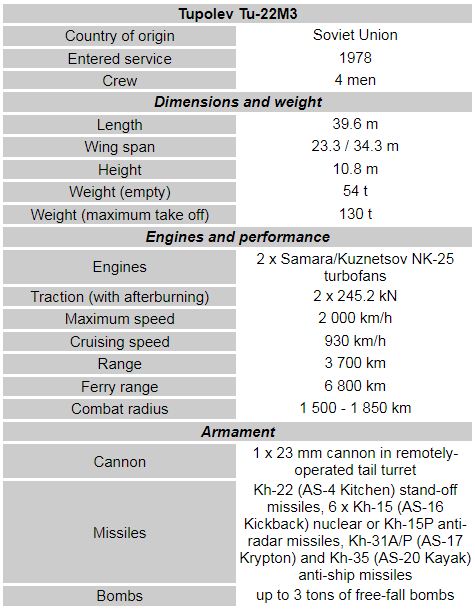 |
| Tupolev Tu-22M |
Militarymedia.net | The Tu-22M (Western reporting name Backfire) was developed from the earlier Tu-22 design, incorporating variable geometry outer wing panels. Although designated as an "improved" version of the Tu-22, it has so many differences that the Tu-22M can be seen as a completely different and much more capable aircraft. The Tu-22M0 prototype first flew in 1969. It was powered by a military derivative of the engine, originally designed for the supersonic Tu-144 (Soviet copy of the Concorde). The Tu-22M is very fast, even at low levels. It was primarily intended to engage US carrier strike groups. However these bombers did not have sufficient range for truly strategic missions and were classified as medium-range bombers.
Currently the Russian Air Force is the sole operator of the Tu-22M series aircraft. It operates over 60 upgraded Tu-22M3 bombers. Although their serviceability rate is around 50% or even lower. It is planned that some of these fighters will be upgraded to the new Tu-22M3M standard until 2020. Even so, the Tu-22M remains a formidable bomber. In 2008 and saw action in Georgia and since 2015 it is sometimes used in Syria.
The Tu-22M0 prototype and pre-production aircraft were followed by an early version of the Tu-22M1. It was known in the West as Backfire-A. However only 9 of these bombers were ever built in 1971 and 1972, until production shifted to better models.
The first serial production model was the Tu-22M2 (Western reporting name Backfire-B). It had longer wings and a redesigned fuselage. The bomber is powered by two NK-22 engines rated at 215 kN each. Production of this model began in 1972. The bomber made its first flight in 1973 and was officially adopted in 1976. In the same year the Tu-22M2 demonstrated a range of about 7,000 km with refueling in a single flight. So while this bomber lacks the range for strategic missions, and cannot reach the United States, its in-flight refueling capabilities expand its range significantly. However in 1991 the Soviets signed the Strategic Arms Reduction Treaty (START 1) which forced to remove the in-flight refueling probe on all Tu-22M series bombers. The Tu-22M2 entered service in 1978. The bomber was produced until 1983. A total of 211 of these aircraft were built for the Soviet Air Force and Naval Aviation. It served during the Soviet War in Afghanistan. These bombers are usually armed with a single Kh-22 nuclear missile and are intended to attack US carrier strike groups. The T-22M2 was plagued with various problems, although the Soviets actively used this bomber.
The main missile/bomb carrier variant is the Tu-22M3 (Western reporting name Backfire-C). The aircraft made its first flight in 1977 and production began in 1978. The "M3" featured reinforced wings, rectangular carded intakes that served the more powerful NK-25 engines. It also had a greatly increased weapon payload (see specs). The bomber can carry up to three Kh-22 missiles. Early production aircraft (or interim aircraft) used a number of available Tu-22M2 components, such as wigs and avionics. The Tu-22M3 in its original form was adopted only in 1989. It was produced until 1993. A total of 268 of these aircraft were built. The Tu-22M3 remains numerically the most important bomber in the Russian Air Force's Long Range Air Force inventory, and serves with seven regiments (one of these regiments also operates the Tu-22M2). The Naval Aviation Force has about 80 Tu-22Ms, mostly M3 models, divided equally between the divisions under the Northern and Pacific Fleet. The Naval Aviation Force also has 12 M3s converted as Tu-22MR reconnaissance aircraft, and is reportedly also operating a limited number of reconfigured Tu-22M2Rs. In 2011 all Tu-22M3 Naval Aviation were transferred to the Russian Air Force.
 |
| Tupolev Tu-22M |
Due to delays in the development of the Sukhoi T-60, the intended replacement for the Tu-22M3, it has been decided to initiate major upgrades to the Backfire. The Tu-22M2/M3 of the Air Force and Naval Aviation will be upgraded to the Tu-22M3M standard, with a new radar, new missile system and automatic terrain following capability. This upgraded version will be capable of carrying new precision strike missiles, such as the new Kh-32 long-range cruise missile. It is planned that the first Tu-22M3M will make its first flight in 2018. It is also planned that a total of 30 airframes will be upgraded to this standard by 2020, although the exact number is not confirmed.
Russia is also testing a small number of Tu-22M3 airframes converted into a Tu-22MP prototype of the planned electronic warfare/jammer escort variant.
 |
| Tupolev Tu-22M |
The only non-Russian Backfire operator is Ukraine. The country acquired the former Soviet Black Sea Fleet Naval Aviation regiment Tu-22M2/M3. About 50-60 Ukrainian bombers equipped three regiments of heavy bombers of the air force. But these bombers are gradually retiring from Ukrainian service. All surviving Ukrainian Tu-22M3 bombers were retired in 2003 and canceled in 2006.









